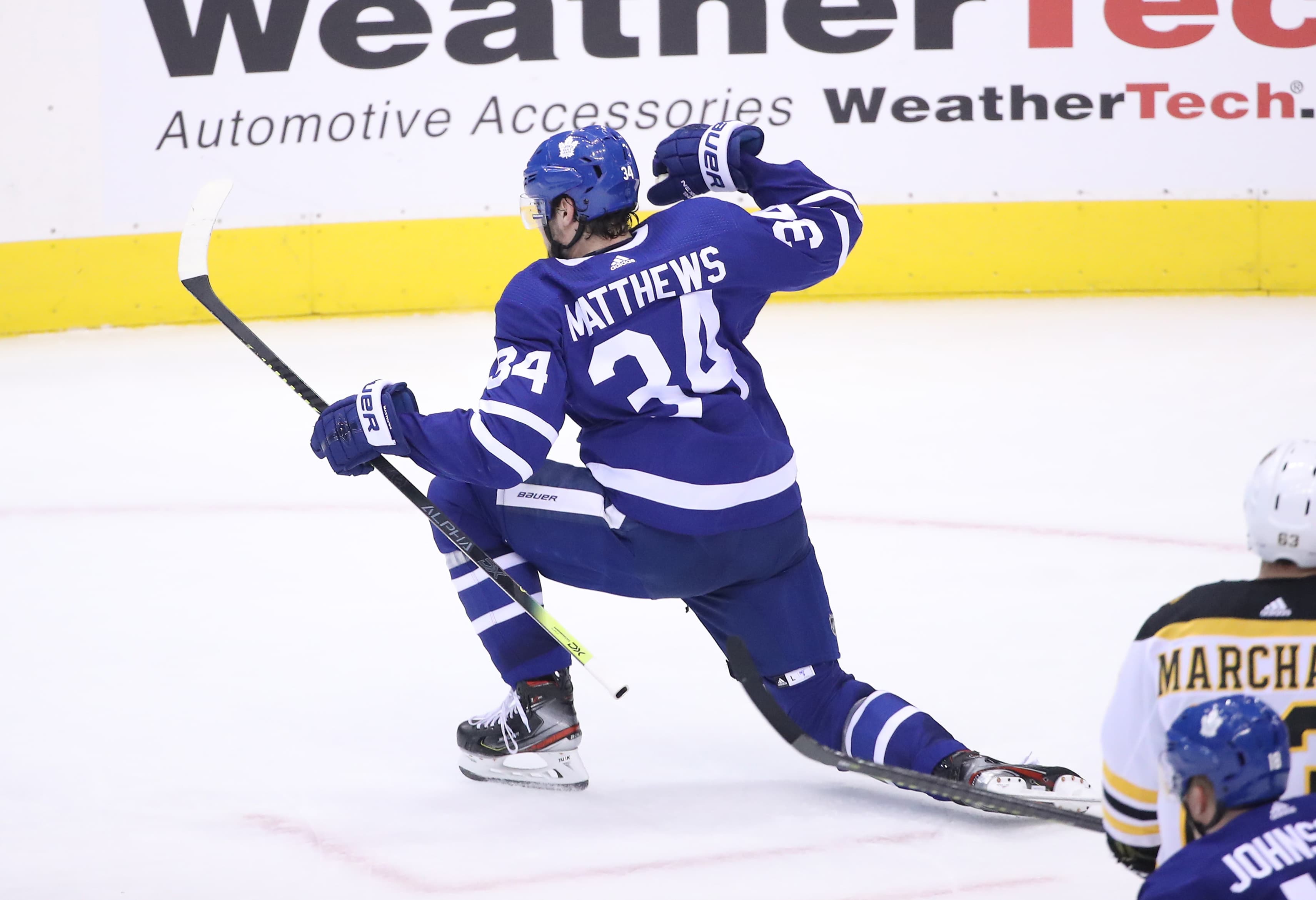Auston Matthews is the Best Goal Scorer in the NHL

If you were to ask most hockey fans who the best goal scorer in the NHL is, I think the most common answer would probably be Alexander Ovechkin. Ovechkin has won the Maurice Richard Trophy as the NHL’s leading goal scorer in six out of the past seven seasons, so it seems like a pretty open and shut case. However, I’m going to explain why Ovechkin’s claim to the title as the league’s best goal scorer is not quite as strong as it initially seems.
Since I’m going to explain why the honour actually belongs to Auston Matthews, we’ll start by restricting all of the statistics we’re looking at to the past three seasons, which is how long Matthews has been in the NHL. If we look at the list of the players with the most goals in that time frame, there’s a familiar name on top.
| Player | Goals |
| Ovechkin | 133 |
| Kucherov | 120 |
| McDavid | 112 |
| Tavares | 112 |
| Matthews | 111 |
| Laine | 110 |
| Marchand | 109 |
| Crosby | 108 |
| Pastrnak | 107 |
| Kane | 105 |
| Tarasenko | 105 |
Ovechkin is still at the top, well ahead of Matthews in 5th place. So why would I claim that the league’s best goal scorer is actually Auston Matthews?
Rates vs Counts
In my recent piece on Mitch Marner’s impressive playmaking, I said the following:
“One problem with looking at the league leaders in counting statistics like goals and assists is that they’re actually a combination of two different things: player skill and ice time. If two players are equally talented at scoring goals, but one gets more ice time, then the player who gets more ice time will finish with more total goals even though they aren’t actually better than the player with less ice time. One way to account for this is to use rate statistics; the most common way to do this is to state how good a player was per 60 minutes of ice time they received.”
So with that in mind, let’s look at the list of the NHL’s top goal scorers over the past three seasons as measured by goals per 60 minutes of ice time.
| Player | G/60 |
| Matthews | 1.74 |
| Ovechkin | 1.64 |
| Laine | 1.62 |
| Pastrnak | 1.58 |
| DeBrincat | 1.55 |
| Kucherov | 1.54 |
| van Riemsdyk | 1.53 |
| Lee | 1.50 |
| Stamkos | 1.49 |
| Marchand | 1.47 |
| Malkin | 1.47 |
Matthews has jumped way up the list, as have some other players. Steven Stamkos, for example, missed nearly the entire 2016-17 season with an injury, but when we look at the rate at which he scored goals, we can see that he was still one of the NHL’s best over the past three years.
Further Adjustments
This method is still incomplete, however. We’ve still got a problem with the ranking here, which is that it will tend to overstate the skill of players who play an unusually large amount on the powerplay.
I expect that this statement could be contentious, so before I dive in, let me explain what the issue is in more detail.
Imagine two players who both score 1.5 goals per hour at 5v5 and 3 goals per hour on the powerplay. I hope we could all agree that both players are equally talented at scoring goals. Now, let’s imagine a scenario where one of these players gets 4 minutes of 5v5 ice time for every minute he gets on the powerplay. Let’s also imagine that the other player only plays 3 minutes at 5v5 for every minute he gets on the powerplay. The second player will wind up with a total goals per 60 minutes rate (1.9) that is higher than the first player (1.8), even though both players are identically talented at goal scoring.
In order to account for that, we need to normalise each player’s ice time to see what their results would be if they played the same minutes. Here’s how I did that:
- I collected every forward who played at least 1000 minutes of 5v5 ice time and 100 minutes on the powerplay between 2016-17, when Auston Matthews entered the league, and 2018-19. This produces a list of 296 players, roughly the entire first and second PP unit forwards for all 31 teams.
- I then figured out what average ratio of 5v5 to powerplay ice time was among this group. It turns out that it’s 86% (ie. on average they played 6 minutes at 5v5 per minute on the powerplay). I’m only looking at 5v5 and PP ice time for reasons that I don’t think are tremendously important, but I’ll explain them in an appendix for anyone who’s interested.
- I normalised each player’s goal-scoring so that they played exactly that ratio of 5v5 to PP minutes.
- I converted the results to a per-60 stat.
Here are the NHL’s top 15 goal scorers over the past 3 seasons using the normalised goals per 60 minutes:
| Player | nG/60 |
| Auston Matthews | 1.72 |
| Alex Ovechkin | 1.44 |
| David Pastrnak | 1.43 |
| Patrik Laine | 1.42 |
| Nikita Kucherov | 1.41 |
| James van Riemsdyk | 1.40 |
| Alex DeBrincat | 1.40 |
| Anders Lee | 1.38 |
| Jake Guentzel | 1.35 |
| Steven Stamkos | 1.35 |
| Jeff Skinner | 1.32 |
| Viktor Arvidsson | 1.30 |
| Vladimir Tarasenko | 1.29 |
| John Tavares | 1.29 |
It becomes clear now just how much better Auston Matthews is than everyone else. The players who looked close to him in the un-normalised G/60 chart were all benefitting from a lot more powerplay ice time than Matthews, which made their results look closer than they really are.
You might have an objection that goes something like this: “You’re looking at too many players. 296 players is nearly 10 per team. Most teams give their top forwards much more powerplay ice time than their second unit gets. It makes perfect sense to load up your top players on powerplay ice time, since that’s when their goal-scoring rates are highest.”
Fair enough. So, let’s create a new list, only this time we’ll limit our results to forwards with at least 2500 minutes at 5v5 and 500 minutes on the powerplay. That reduces the list by nearly 2/3, to 108 players, roughly three per team, way down from the original list that had 9.5 players per team. And it turns out that those players do get more ice time on the powerplay; this group has an average ratio of 5v5 to powerplay ice time of 83%. If we re-run the list with that new weighting, we get this:
| Player | nG/60 |
| Auston Matthews | 1.76 |
| David Pastrnak | 1.49 |
| Alex Ovechkin | 1.49 |
| Patrik Laine | 1.49 |
| Nikita Kucherov | 1.45 |
| James van Riemsdyk | 1.44 |
| Anders Lee | 1.43 |
| Jeff Skinner | 1.34 |
| John Tavares | 1.33 |
| Vladimir Tarasenko | 1.32 |
| Evgeni Malkin | 1.32 |
| Viktor Arvidsson | 1.30 |
| Brad Marchand | 1.28 |
| Cam Atkinson | 1.28 |
The list remains largely unchanged, except that we’ve lost some players who no longer reach the ice time threshold, like DeBrincat and Guentzel. (Leafs and Avalanche fans may be interested to know that Nazem Kadri is just outside this list at #18, slightly ahead of Sidney Crosby.)
Because we’re looking back over the past three seasons, the list here doesn’t necessarily capture current goal-scoring talent. For example, James van Riemsdyk has been an elite goal scorer over the past few seasons, but now that he’s past 30-years-old, we would expect his results to decline.
That shouldn’t apply to Auston Matthews, though. At 22, Matthews will likely continue to improve as he into his mid-20s. Barring a major injury or some other unforeseen setback, then, his results wouldn’t be expected to change too much.
None of what I’ve written here should be read as taking anything away from Alexander Ovechkin. Ovechkin is one of the best goal scorers in the history of the NHL (maybe even the best). It would be an incredibly tall, and probably unlikely, journey for Matthews to equal Ovechkin’s career. But if we want to know who is the best goal scorer today, the answer is Auston Matthews, and no one else is close.
Appendix: I’ve normalised goal-scoring using 5v5 and powerplay ice time, which means I’ve left out some game states. Most of them are fairly small, like 3v3 or 6v5, and so goal-scoring in those states doesn’t strike me as having a sufficiently large sample size to determine who is actually good at them.
The one major game state I’m leaving out is shorthanded, and that’s because most of the top goal-scorers don’t play enough on the PK (if they even play at all), so once again there’s a sample size issue. The vast majority of goals in the NHL are scored at 5v5 or on the powerplay. In the 2018-19 season, 87% of all goals were scored in those game states. So while I am failing to include situations in which roughly 1 in 8 goals are scored, I think looking exclusively at 5v5 and PP goal scoring does the best job of capturing as many goals as possible while leaving out situations that could tend to make the results less reliable due to infrequency.
Recent articles from Drag Like Pull




